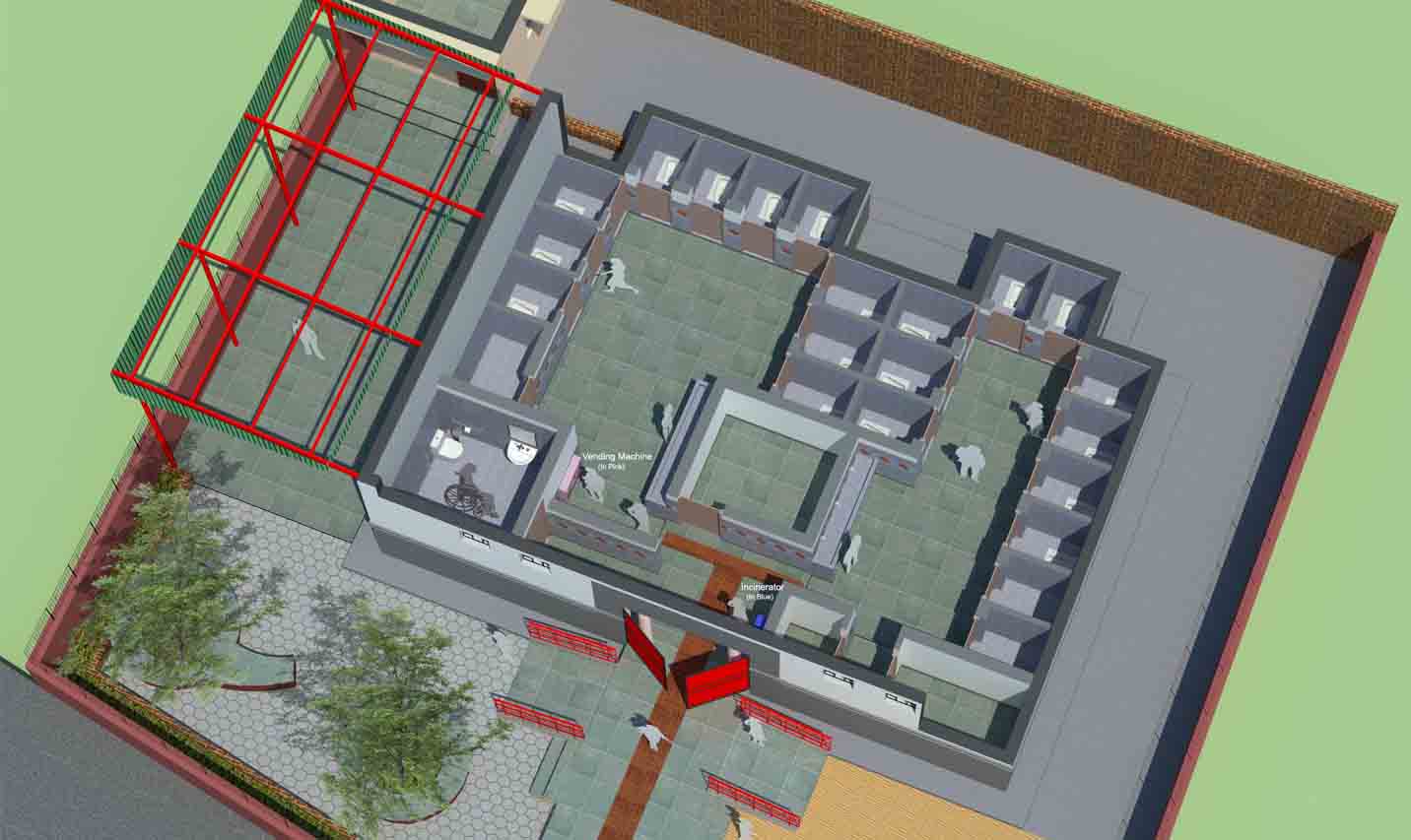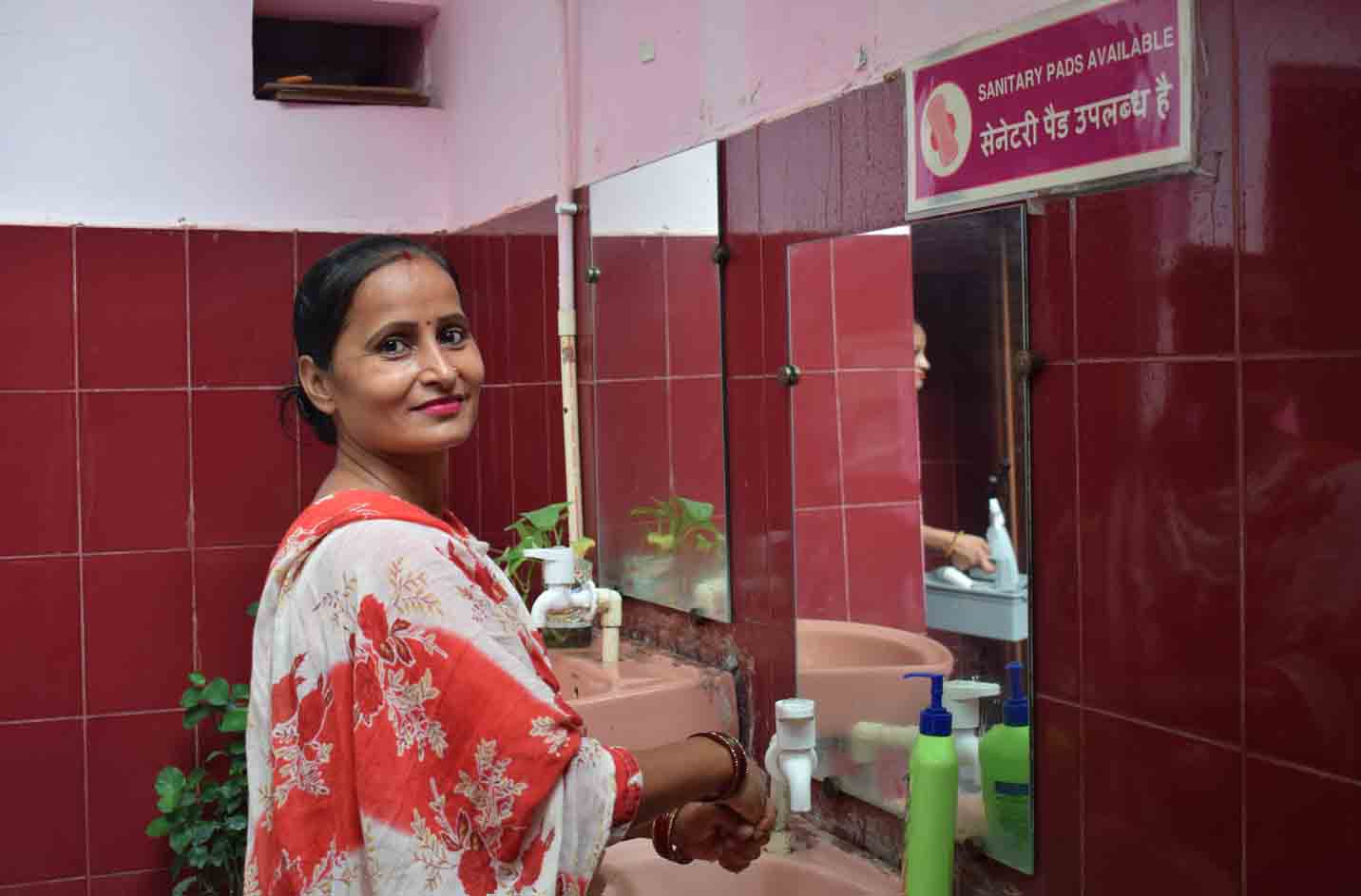
The pace of urbanisation that our country is witnessing has always been a subject of concern for policy makers. With development of the services sector, mass migration adds on to the pressures of population increase in cities. Increasing density of population instills fears of catching airborne diseases and deprivation of sunlight due to the proliferation of slum households. A significant portion of Delhi’s population lives in slums amidst substandard conditions aggravated by dirty water, clogged and open drains, narrow lanes, cramped houses and heaps of garbage, devoid of basic necessities like proper sanitation and water supply.
In 2017, PVR NEST was invited by the National Commission of Protection of Child Rights (NCPCR) and the Municipal Corporation of Delhi (MCD) to conceptualise a public facility that would help meet the safety, privacy and hygiene concerns of women and children, and bring about inclusivity for People With Disabilities (PWDs) and transgendered people. This led to the formation of Pink Centres in 2018. These safe centres have resulted in behavioural shifts among the users towards sanitation, has increased the usage of sanitary pads and made these community washrooms a sanctuary for women without access to feminine hygiene products and safe public toilets.
These 20 centres further paved the way for over 100 WASH Champions to lead dignified lives through a regular form of employment at these centres. Periodic skilling workshops on WASH practices, plumbing, CPR, self-defense and financial literacy empowered these women to become self-confident.
It gave a new identity to the sanitation attendants, these ‘WASH Champions’ who saw themselves in a new light commanding respect from the community for their contribution. PVR NEST was able to create a new model on how public toilets in our country could lead to the overall development of the community around it. During the Covid-19 outbreak in 2021, with several vital facilities being shut, Pink Centres continued to operate with Covid-19 protocols thanks to the immense courage and determination displayed by these WASH Champions. In its endeavour to make sanitation equitable, the centres garnered 5 lakh plus users.

Why is this rethinking of toilets as multipurpose spaces important?
Women and children are vulnerable sections of society. Their health, safety and well-being are vital facets that get neglected due to lack of accessibility to safe toilets and Menstrual Hygiene Management (MHM). Lack of awareness of MHM, taboos and inaccessibility to toilets have compounded the problem with women and girls having to defecate openly, becoming more susceptible to Urinary Tract Infections (UTIs) and eventually Cervical Cancer.
Toilets as ‘multi-utility’ centres: The advent of Garima Grih
Having achieved its vision of converting Pink Toilets to Pink Centres, PVR NEST is assuming a wider role with its next phase of progression for Pink Centres with the ‘Garima Grih’ initiative, an inclusive Multi-Utility Safe Complex at Jawahar Camp, Kirti Nagar. In 2021, an old bathing/toilet facility was provided by the government to PVR NEST for developing it into a model sanitation centre. The site was strategic as it was being used by over 10,000 households from Jawahar Camp, Harijan Camp and Chuna Bhatti Camp. A higher footfall of users – more than 10 lakh annually – could be seen as a chance for better social impact of equitable sanitation and skilling opportunities for the community.
The architects responsible for the project were given clear goals: Low toilets and basins for children; ramps and support railings for the elderly and People With Disabilities (PWD); toilets with adequate space for the PWDs to manouvre. The premises needed to be well-lit with adequate ventilation and provide multifarious facilities while also adopting green practices.
These safe centres have resulted in behavioural shifts among the users towards sanitation
How did the COVID-19 pandemic prompt this change in thinking?
The pandemic has taught us the importance of personal and public hygiene and the need for investment in disease preparedness. Garima Grih will pave the way for other states in the country on how to transform urban spaces and facilities to make cities more liveable. It will protect marginalised women and children at risk in disadvantaged communities by improving their social well-being.

How do Garima Grih’s promote inclusivity in their physical urban context?
Strategic/Mission-oriented/Policy alignment: In order to achieve the best potential of Garima Grih, PVR NEST has on-boarded reputed social impact organisations to support its vision of positioning Garima Grih as an all-inclusive holistic centre for safe, sanitation and hygiene management, skilling and income-generation initiatives. Garima Grih is built on the basis of a thorough understanding meeting 9 of the 17 Sustainable Development Goals (SDGs). Garima Grih is aligned to the government’s Smart Cities Mission, Swachh Bharat Mission and the Atal Mission for Rejuvenation and Urban Transformation 2.0 (AMRUT 2.0) and the National Skill Development Mission.
Multipurpose and flexible space: It has a Common Services Centre, ‘Jan Seva Kendra’, offering digital services for the public, which is completely run by women. The ‘Mahila Sashaktikaran Kendra’ (Women’s Empowerment Centre) will be used for skill development of women, teaching them essential skills to earn a livelihood. Additionally, there is a covered open space for women to rest after a hard day’s work, which doubles up as an area to run capacity-building workshops for developing skills and competencies of the neighbourhood community. Towards meeting the skill development objective, 200 unique stakeholders will be provided computer skills, 100 reading and writing skills with over 2000 women expected to be skilled in the next three years.
Accessible and inclusive for all: Garima Grih is completely accessible through ramps and is inclusive (friendly for Persons With Disabilities, senior citizens and children). Women can access Menstrual Hygiene products through a Sanitary Napkin Vending Machine and can dispose of them in a sustainable way through incinerators. Besides toilets, there are changing rooms, bathing and handwashing areas.
The pandemic has taught us the importance of personal and public hygiene and the need for investment in disease preparedness
The pandemic had a devastating effect, especially on the poor and vulnerable, and exposed long-standing gaps in public health infrastructure in our country. Certain population groups were more susceptible to the health crisis through their social and economic inequities. It is clear that long-term strength and resilience of our healthcare systems will be greatly determined by how the government, corporates and the social sector together tackle such health crises. Urban planning is crucial for better public health in overcrowded cities facing health threats on account of infectious diseases and inadequate access to sanitation and hygiene facilities.
Deepa Menon is the Founder and Head of PVR NEST. PVR, a leading film exhibitor runs PVR Nest as its comprehensive CSR programme.
All Photos: Deepa Menon



Comments (0)